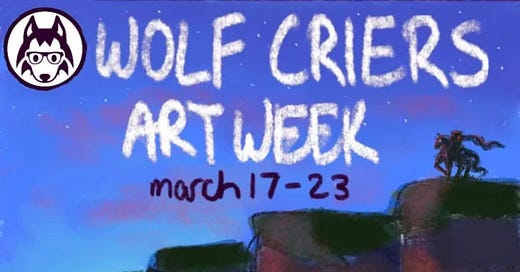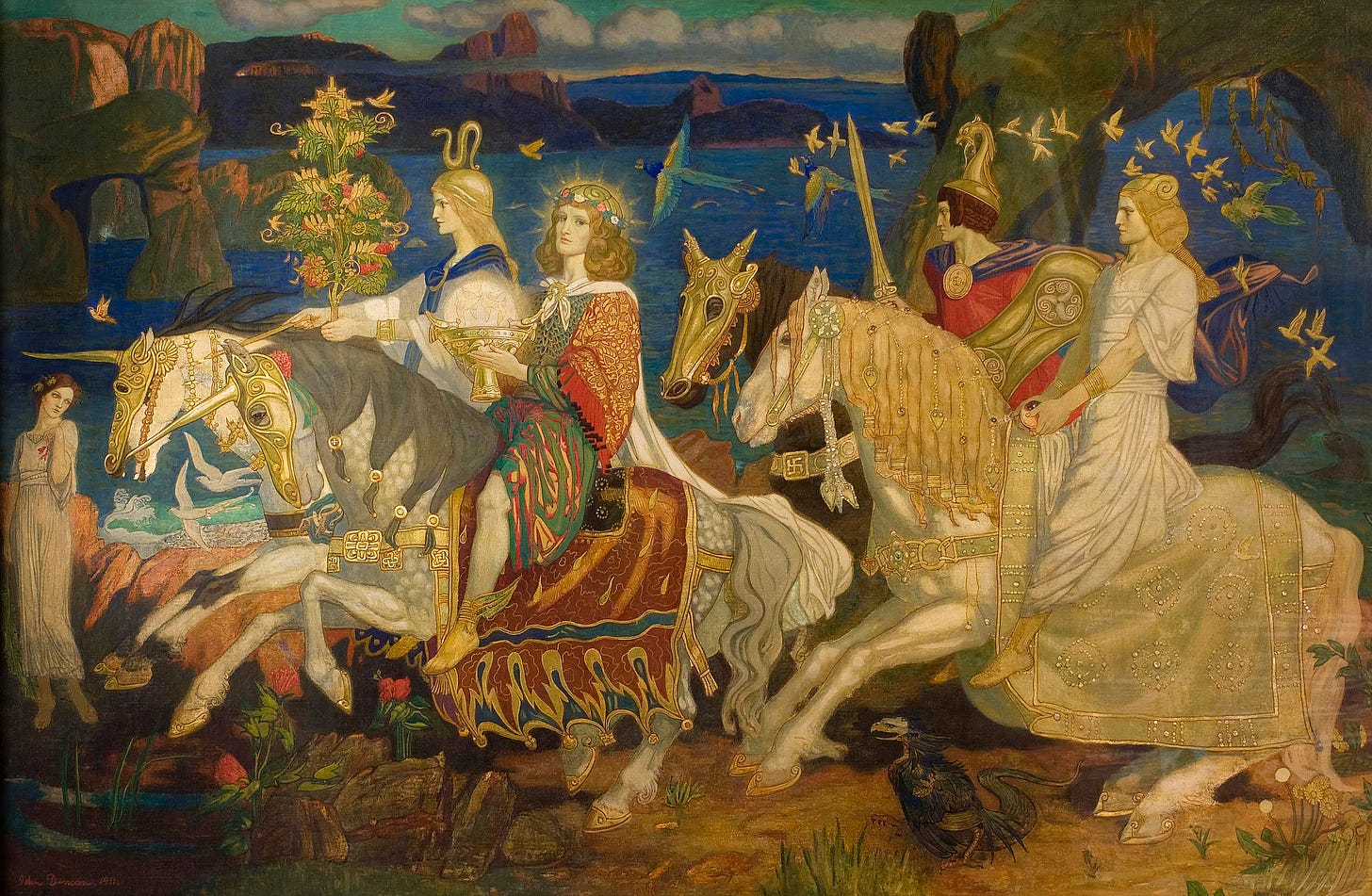Wolf Criers Club
Vol 32
Wolf Criers Club Art Challenge Kicks Off March 17
Our first ever Wolf Criers Club Art-Challenge kicks off on Monday.
AwoooOoOoOoOoooOoo!
Those wishing to run with us this week can post work on our Daily Substack Subscriber thread — if you are receiving this email, then you are on the list.
Other ways to share your work are on Instagram or BlueSky with the hashtag #wolfcriersartweek.
Our week of daily art challenges begins with a look at Leprechauns. What mischief and magic might this inspire?
While some people may be posting finished work, showing dazzling color and loads of skill, some will be posting doodles, line drawings, stick figures, or even photographs that meet the challenge.
If you are writer, why not make the picture with words?
A 100-word, 50-word, 10-word story or a poem could be what you offer.
The challenge is about doing something every day for a week, and like a wild ride on the back of a Pooka, venturing into unexpected places.
And then, in a week, we arrive back again. Only we will have made some new connections between ourselves and our art and within the Wolf Criers Club community.
Why not come along?
All are welcome to draw, paint, or craft in whatever form of art you enjoy and run with us Wolf Criers.
Here are some starting points for the various prompts, including links to Wikipedia for more complete information and descriptions of the folk and fairies from Irish Folklore.
Day One: Leprechaun
These small, solitary fairy-folk possessing magical powers are often depicted in green garb with red beards or locks. Leprechauns might play tricks on human-folk, cobble shoes, or guard pots of gold at the end of rainbows. When caught by humans, they may grant three wishes in exchange for freedom.
Day Two: Merrow
These Irish merfolk have ocean-green hair, teeth, and skin and webbing between fingers and toes. Female merrow are beautiful with fishtails and wear special caps to control their movement between sea and land. They collect the hearts and affection of land-dwelling humans. In contrast, the male merrow can be grotesque with pig-like features and red caps. They're known to lure humans into the sea beguiling them with song or by occasionally marrying them.
Day Three: Púca/Pooka
A mischievous spirit whose intent can be as much good as it might be ill. The Pooka is a shape-shifter taking the form of many creatures from a human to a goblin to a hare, but is often encountered as a horse. They are said to entice a person onto their back for a wild ride across landscapes, traversing realms, before returning to the place where the encounter began. A ride on the back of a pooka might last an evening, a day, a week, a longer span? It always gives the human companion a rollicking tale to recount.
Day Four: Banshee
A female spirit who heralds death by wailing or keening near the home of someone about to die. Often depicted as a pale woman with flowing hair wearing white or gray, she may appear as a beautiful young woman, a matron, or an old crone. Some traditions connect banshees specifically to certain Irish families.
Day Five: Changeling
This may be the offspring of a fairy, troll, or other mythical creature left in place of a human child who has been stolen away. Changelings appear identical to the original young human but develop abnormally and may fail to thrive or display odd behaviors such as unusual intelligence or magical abilities. They're often depicted with wizened features despite their apparent youth.
Day Six: Selkie
Seal-folk who can shed their seal skins to assume human form on land. When playing at being human, they are beautiful and graceful. Legend says that capturing and hiding a selkie's skin forces them to remain human and bound to the captor, though they'll return to the sea if they ever recover their skin. A selkie may enjoy their time on land and form bonds with human folk, including children, but is a creature ever longing to return to the sea.
Day Seven: Aos Si
the ‘Folk of the Fairy Mounds’ are often likened to elves said to dwell in burial mounds that serve as portals to the Otherworld. They are called The Fair Folk, The Good Neighbors, or simply The Folk, and can be appeased thru offerings and care taken not to anger them. Often depicted as tall, beautiful, luminous beings with flowing hair and swathed in archaic clothing. They're known to be powerful, capricious, and potentially dangerous when disturbed.
Oh - and if you’re looking for an Irish music fix to inspire and delight you on this artistic quest - check out The High Kings. They are a bridge between traditional Irish music and modern Irish sounds and always get the temperature to rise in any room that they play.
Kato McNickle composed this week’s newsletter.
Folklore Challenge lead wolf is Kayleen Sokol.
Wolf Criers Club is a collective of illustrators, writers, innovators, and wolves.
We explore aspects of dynamic storytelling each week through pictures and words, how to improve, and where to take it next. Why not run with us?
If you enjoy this post, please share it with arts-minded friends and subscribe or follow Wolf Criers Club on Substack for weekly updates.
The wolf-wearing-glasses logo is by Wolf Crier Michael Luk.






I am REALLY looking forward to following this challenge!
This is going to be so much fun!